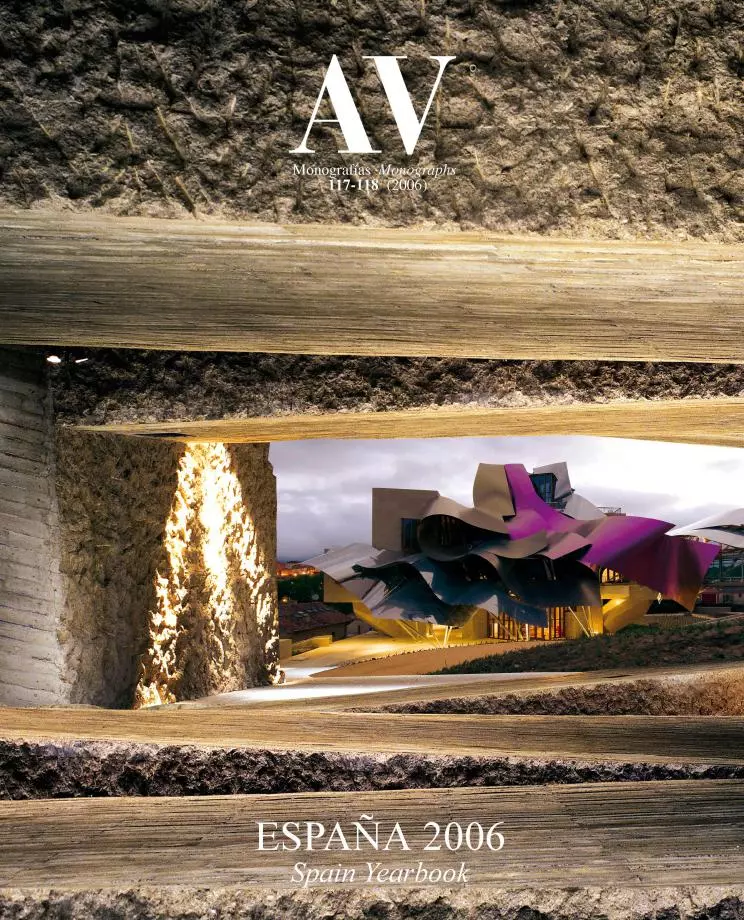Albert Speer, Light and Darkness
The work of the Führer’s architect, who would have turned a hundred this month, illustrates well the relation between the arts and totalitarian politics.
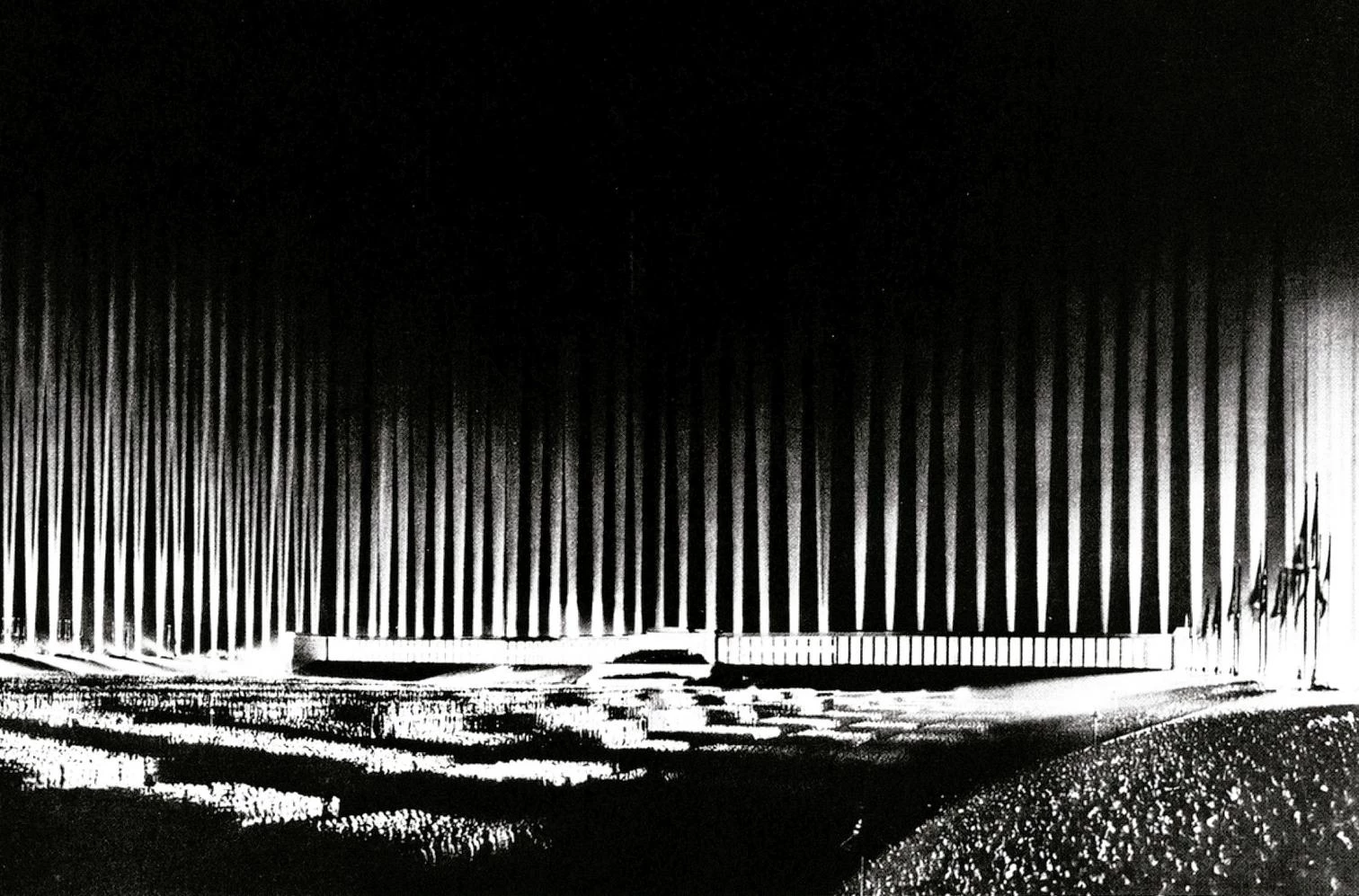
The genius was Hitler. Albert Speer, his architect and confidante, was only or above all anefficient technocrat who with models and buildings managed to give shape to the Führer’s visionary dreams. The well-to-do, cultured young man who converted to the Nazi credo after succumbing to Adolf Hitler’s hypnotic oratory always considered the latter his tutor in the field of the arts, and accepted his opinions in architectural matters more with the docility of the disciple before a master than with the submission of the militant to a leader.

Adolf Hitler shared with Albert Speer the passion for projects, which they supervised together.
If one compares the self-taught skill evident in the architectural sketches of the dictator with the routine drawings of his follower and interpreter, it is easy to see that Speer’s pupil-like subordination had true bases, and that his artistic admiration for the Führer, expressed in profuse detail in his Memoirs, was no mere reflection of political fascination. As is known, the young Hitler made a living as a small-time illustrator and described himself in identification documents as a ‘painter of architectures’. When he came to power, he put at the young Speer’s disposal an army of staff with which to materialize his architectural utopia. If Leni Riefenstahl, the film director of the Third Reich, had 30 cameras to film Triumph of the Will, and 45 for Olympia, Speer had a thousand employees at his command. No appraisal of the aesthetic achievements of either can be made without reference to the colossal means placed at their service by the totalitarian state.

The ‘cathedral of light’ that framed Nazi rallies in Nuremberg resorted to rows of spotlights to form an immaterial colonnade, in tune with the theatrical nature of a regime that yearned to be considered a ‘total work of art’.
This is not to say that Speer had no talent. He was a skilled architect, even if he failed to get admitted as a student of Poelzig because his drawing was not good enough. But he was more gifted as a scenographer, as an organizer, and as a politician, three areas in which his mentor surpassed him by far. He became acquainted with public projects in 1933, working first for Goebbels and later on in the design of the scenography for the Nuremberg rallies of the Nazi Party, which had come to power that year and which Speer had joined in January 1931. But all this was under the supervision of a true master of political theater, author of the party’s corporate identity and an inspired set designer whose hiring by the Vienna Opera, had it happened, may have altogether changed 20th-century history. Speer showed his organizational competence, from 1937 on, as General Inspector of Building, a post that put him in charge of plans for Berlin’s urban renewal, and from 1942 on, as Minister of Armaments, by which he was responsible as much for highways and fortifications as for the war industry. But in both capacities he was at the service of a charismatic tyrant who with ominous genius brought Germany’s expansion to a catastrophic finale. And he proved his political dexterity by reaching the highest positions in the Nazi state, introducing himself into the intimate circle of power and, getting around conspiracies and envies, remaining there until the very final hours of the Berlin bunker. But again, his tragically brilliant career can only be explained as the result of the paternal protection of Adolf Hitler, who had an affection for him that was based on a shared passion for architecture.
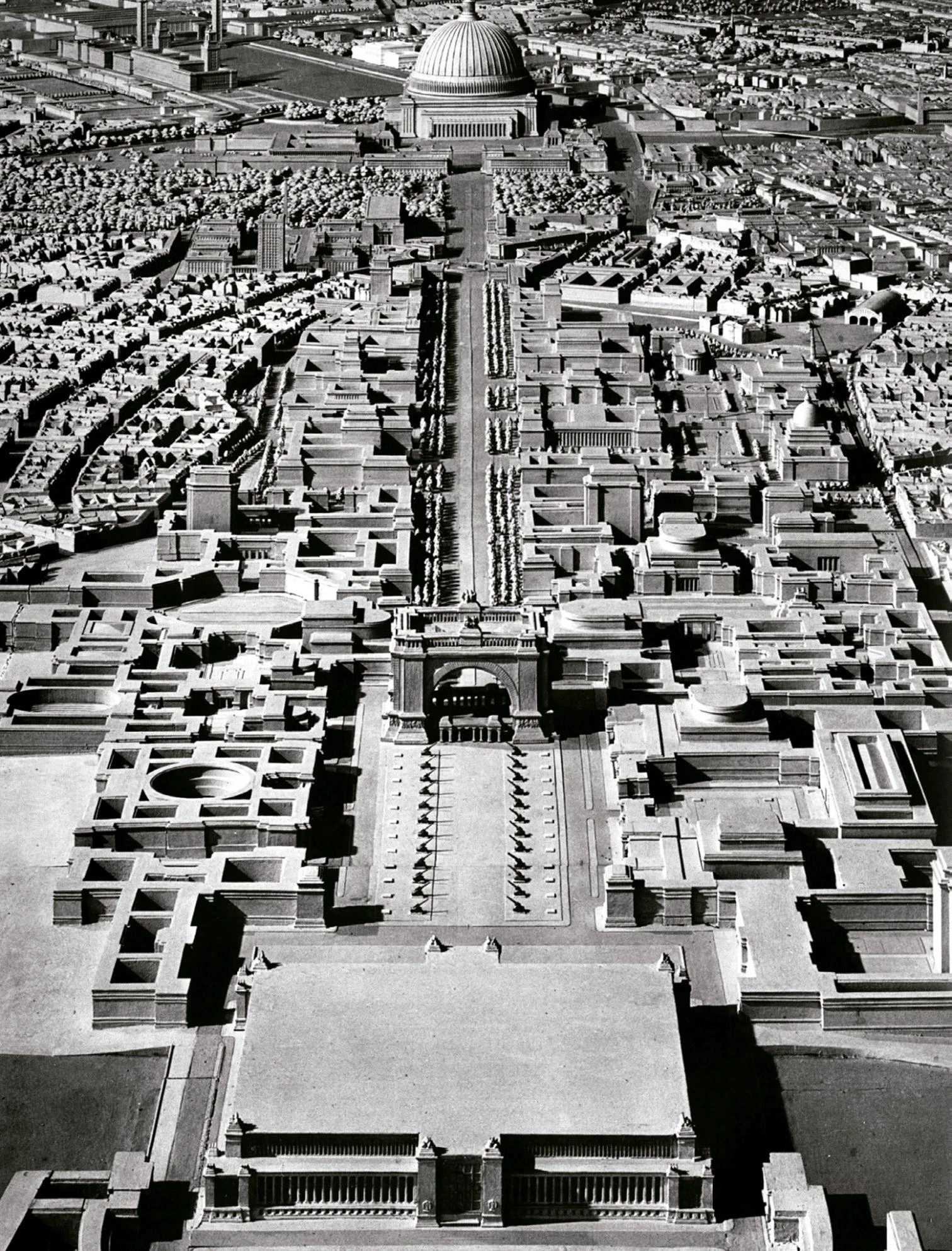
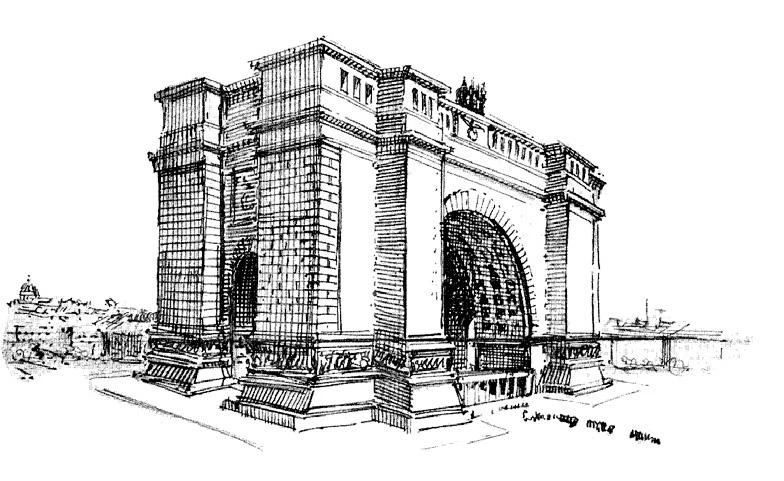
The great north-south axis of Berlin, which was only materialized as a colossal model (above), started with an arch of triumph designed by Speer in accordance with the project drafted by Hitler himself in 1925 (right).
Son and grandson of architects, and father of one who with the same name now heads a major German architectural office, Albert Speer trained with the traditionalist Heinrich Tessenow, becoming his assistant. Hence Speer’s familiarity with the classicism of the Dane Carl Peterson or the Swede Gunnar Asplund: Nordic influences that blended, in the common matrix of the then dominant Wagnerschule, with the Prussian monumentalism of Gilly or Schinkel, interpreted successively by the domestic Behrens and the institutional Troost, to form a colossal and rhetorical neoclassicism with which the architect would claim to have tried to emulate “the melancholic grandeur of Juan de Herrera”. This solemn style, which he used in the great projects of 1935-1942, would only sometimes get materialized. A case in point was the grandstand, inspired by the altar of Pergamum, that he built in the Zeppelinfeld of Nuremberg in 1935. Another was the new chancellery he erected for Hitler in Berlin in 1938. But the outbreak of war in 1939 interrupted most of the projects, and the more ambitious ones were reduced to the stage of giant models, from the huge domed hall that wrapped up Berlin’s north-south axis, conceived as a splendid processional avenue, to the palaces designed for the Führer and Marshal Hermann Goering.

To be sure, this imperative classicism was not exclusive to Germany, being at the time also used in Mussolini’s Italy, in Stalin’s Soviet Union, or in Roosevelt’s United States for grand institutional works. Neither was it the only style of the Nazi regime, which with equal conviction promoted the neovernacular in rural areas and the modern in factories and roads – Mies van der Rohe himself designed gas stations, and among Speer’s assistants were the laconic Bonatz and Neufert, an advocate of standards. But it was indeed the language by which totalitarianism chose to represent itself in its symbolic heart (Speer actually said that these architectures “must not only express the essence of the national-socialist movement… they must be an integral part of it”), and Hitler’s personal participation in its design was in tune with his operatic, Wagnerian conception of the national-socialist state as the ‘total work of art’, a matter that Jean Clair clarified with particular analytical sharpness and that Frederic Spotts has widely documented inHitler and the Power of Aesthetics. Having in hisyouth drawn up numerous buildings using the academic language of Vienna’s Ringstrasse, the Chancellor gave Speer’s work something more than the political support of a powerful patron. From the great domed hall, elaborated on the basis of drawings of Hitler inspired by Rome’s Pantheon, to the triumphal arch of the north-south axis, which literally reproduces the project designed by the Nazi leader in 1925, there is no visionary model for Berlin or Nuremberg – or for Munich or Linz with other architects – that does not reflect the artistic intentions of the Führer.
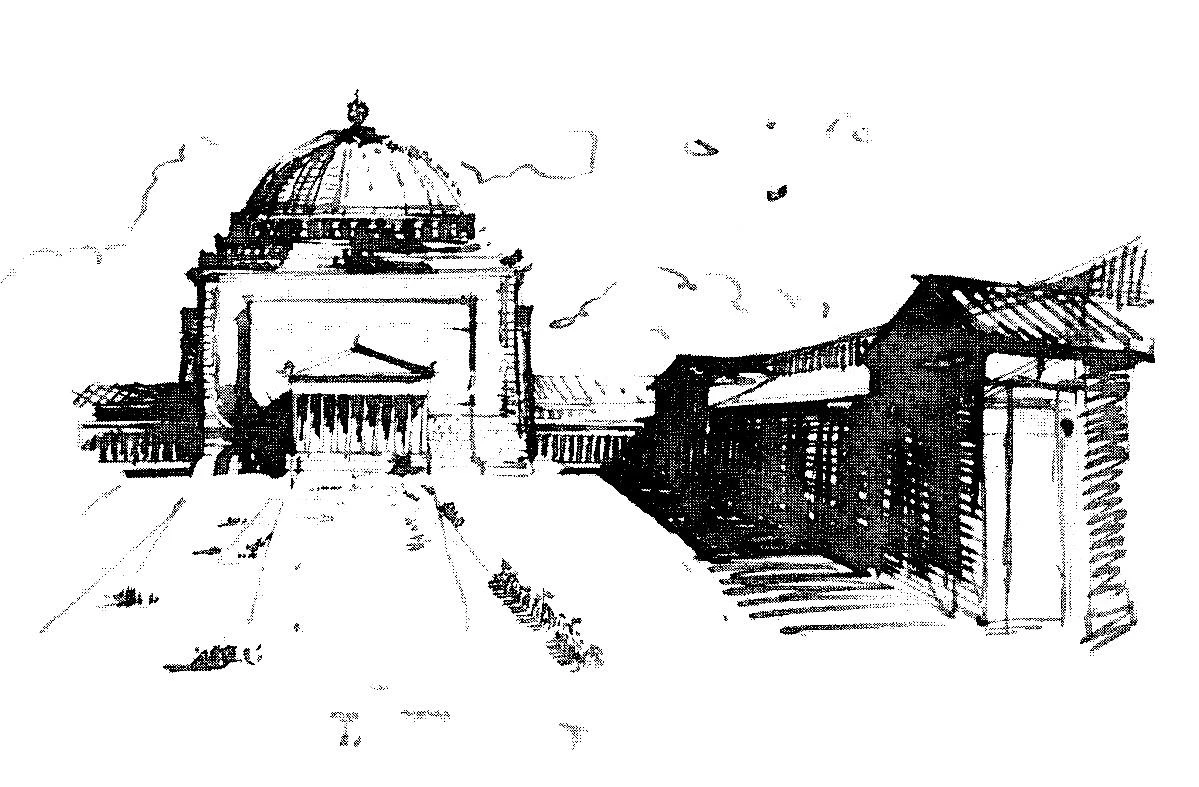
The processional avenue ended in a monumental hall topped by a dome (above, view through the triumphal arch), equally devised in the sketches by the Nazi leader, who in this case took inspiration from the Panteon (right).
Speer’s Faustian pact with Hitler did not, as they fantasized in their writings, leave behind a landscape of ruins whose grandeur would in future speak of the titanic scale of their endeavor. The constructions that were not interrupted by the war were demolished after it, and nothing remains of that colossal and perverse utopia but pale images (kept hidden by the sense of decency of de-Nazification until the 1975 Stockholm exhibition on Speer that was organized by Lars Olaf Larsson, author, too, of the monumental book on the architect’s complete works, published in German in 1978, then in a bilingual, French-English edition in 1985 under the auspices, in Brussels, of Maurice Culot, enriched here with an extensive and controversial apologetic text by Léon Krier: architectural precursors of the 1999 biography of Joachim Fest and Heinrich Breloer’s recent television series on the relationship between Speer and Hitler, a subject that in turn appears as an episode in Oliver Hirschbiegel’s The Downfall. Retrospectively, and perhaps in tune with the somberly theatrical nature of national-socialism, what Speer described as “the fascination and terror of those years” is admirably summed up in the ‘cathedral of light’, the sublime, immaterial colonnade of spotlights that framed the mass rallies of Nuremberg. This same city would be the scene of the trial of the Nazi leaders, where Speer was condemned to serve a 20-year sentence in the solitude of Spandau prison. Following his release in 1966 he went to London, and lived there until his death in 1981. From the memoirs that he wrote during that time we extract an introductory passage that should serve as an epilogue for this essay, and perhaps also as an epitaph of a life of light and darkness: “At the Nuremberg trials I said that if Hitler had had friends, I would have been one of them. To him I owe as much the enthusiasms and the glory of my youth as the horror and the guilt that came later”.

